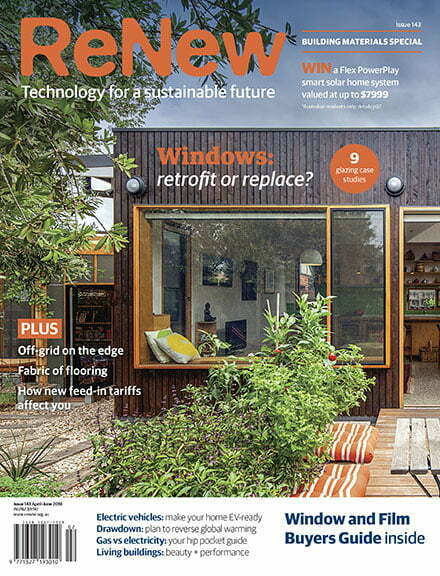Gas versus electricity: Your hip pocket guide
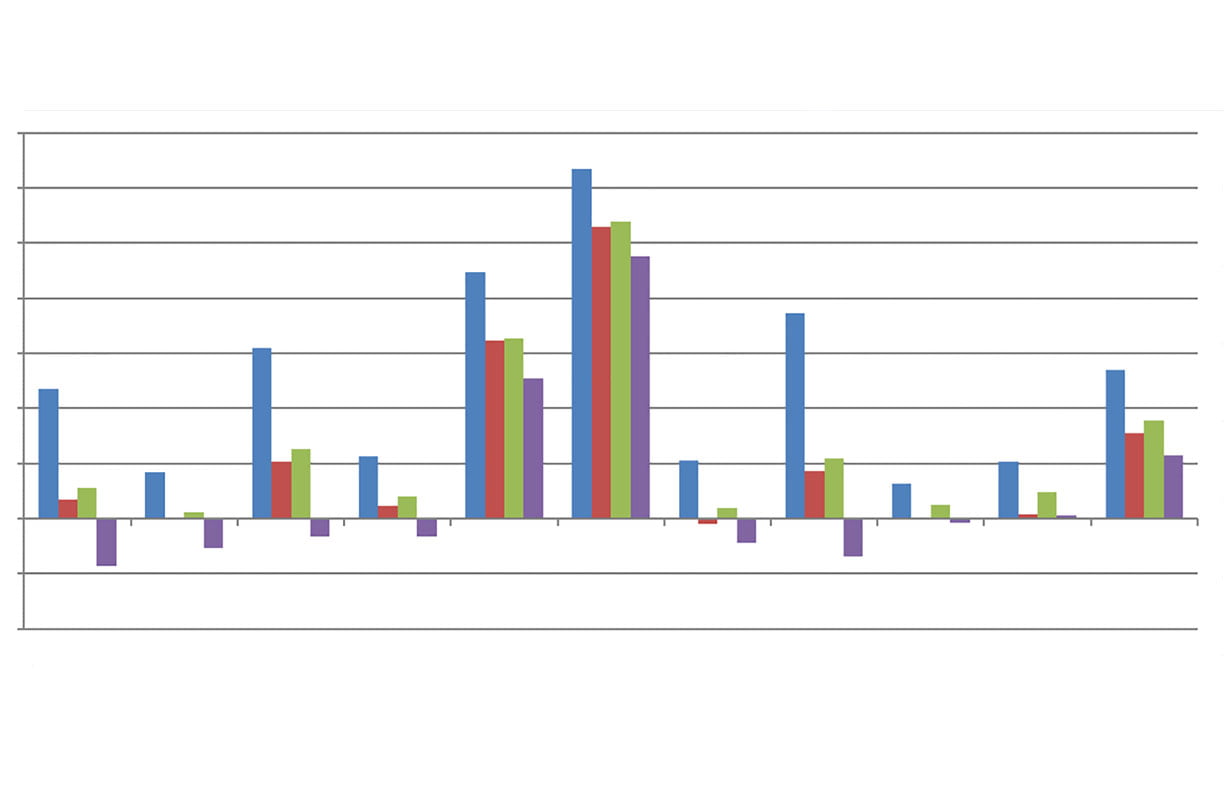
Renew’s latest study updates our modelling to give more accurate estimates of the savings or costs over 10 years when switching to electricity from gas for heating, hot water and cooking, and adds solar to the equation. Energy analysts Dean Lombard and Keiran Price report.
This article was first published in Issue 143 (Apr-Jun 2018) of Renew magazine.
In 2014, Renew, Renew magazine’s not-for-profit publisher, released a study which compared the economics of gas and electricity for a household faced with a ‘fuel choice’ decision. Such a decision occurs when a household needs to replace a failed appliance that uses gas or electricity, such as a space heater, hot water system or cooktop, or when they’re building a new home. The question the study sought to answer is: which is cheaper, gas or efficient electric appliances, when considering purchase price, installation cost, and maintenance and usage costs over 10 years.
That study found that in many situations, especially new builds and existing all-electric homes, choosing to go (or remain) all-electric was cheaper. Further analysis released in 2015 found that switching from gas to efficient electric appliances also reduced CO2 emissions. Since then, the all-electric option has been promoted by Renew as a win for the environment and for your hip pocket in many cases.
Over the last year, Renew has revisited the 2014 economic analysis, thanks to funding from Energy Consumers Australia. We’ve improved our modelling approach and conducted analysis to determine whether technological developments and energy market changes since 2014 have changed the outcome. We also analysed the extent to which rooftop solar favours the switch to electricity.
Improvements in our new study
In our new study, we modelled the costs of heating, cooling, hot water and cooking for five archetypal household types in 16 different locations around Australia. Our new model has meant we can much more closely understand the impact of different climatic conditions, household sizes, energy consumption profiles, and local gas and electricity tariffs on costs. The five household types we modelled are:
- two people, frugal energy users, small home
- four people (two adults, two kids) with a ‘stay-at-home’ profile (i.e. high weekday daytime usage) in a medium-sized house
- same as above, but with a ‘working’ profile (i.e. low weekday daytime usage)
- five people, large home
- same as the above, but newly-built.
For each of the five household types, we selected appropriate electricity interval datasets (records of half-hourly usage) from our library of smart meter data to provide a model of underlying electricity consumption.
We developed a model to calculate hot water, heating and cooling requirements on a half-hourly basis for each of the household types. This allowed us to use Sunulator, our solar generation modelling tool, to more accurately calculate electricity bills, including how much solar generation offsets electricity usage of heaters, air conditioners and hot water systems. We also built a model to more accurately calculate gas bills.
Finally, we built an integrated fuel cost comparison model to do the full comparison. It calculates cooking energy requirements, uses relevant cost data from the other models and adds in maintenance and capital costs.
Testing and assumptions
We checked our energy usage modelling outcomes extensively against benchmark and survey data. A reference group of energy experts, energy company representatives and energy consumer advocates guided and informed us during project development. In particular, the reference group helped us ensure that appliance options were locationally appropriate.
We’ve assumed that gas heating is ducted in Victoria, ACT and all newly-built homes regardless of location. In existing homes in Tasmania, South Australia, New South Wales and Toowoomba, we’ve assumed that heating is via a gas wall furnace with supplementary portable gas heaters (one to three, depending on dwelling size). We did not model gas heating in Brisbane due to its low incidence. Also, as there’s little mains gas in Tasmania, the Hobart results apply to very few people.
For electric heating, we’ve modelled using reverse-cycle air conditioners, with a large unit in the main living area and smaller units elsewhere (one to three, depending on dwelling size). For hot water, we’ve assumed that gas hot water is instantaneous for small and medium dwellings, and storage for large ones. Electric hot water is heat pump storage for all dwellings, timed to heat during the day when solar generation is available. For cooking we’ve assumed that gas stoves comprise gas cooktop with gas oven, and electric stoves comprise induction cooktop with resistive electric oven.
Our modelling compares the total cost of ownership (purchase, installation and running cost) after 10 years, using a 10-year net present value (NPV) (see below for more on NPV).
Some same, some different results
Some of our results were quite different this time than in 2014. Others were the same.
Some of the differences were due to the improvements we made to the modelling and approach; others were due to changes in tariff rates and structures. In particular, increased electricity prices and gas tariff structures that actually reward high gas usage have made a big difference in South Australia.
Despite considerable variability in results for different scenarios and locations, we found a handful of key principles that can guide the economics of fuel choice decisions, outlined below.
New homes: go all-electric with solar
For new homes, the best choice is clear: go all-electric and install solar PV (see Figure 1). In every location around Australia, you’re much better off than if you choose gas appliances and no solar. The worst return is in Melbourne, but even there you’ll be almost $10 k in front after 10 years. The reasons for this differ depending on location. In Hobart, it’s the savings from choosing to heat via efficient electric rather than gas; in Adelaide, you benefit from better solar conditions and avoid high electricity costs; but, in every case, for a new home the best option is all-electric with solar PV. In those cases where you can’t install solar PV, going all-electric is still the best option, but the level of benefit varies much more. In places like Hobart and Canberra the return is still very positive; in Adelaide and Sydney, it’s a marginal benefit.
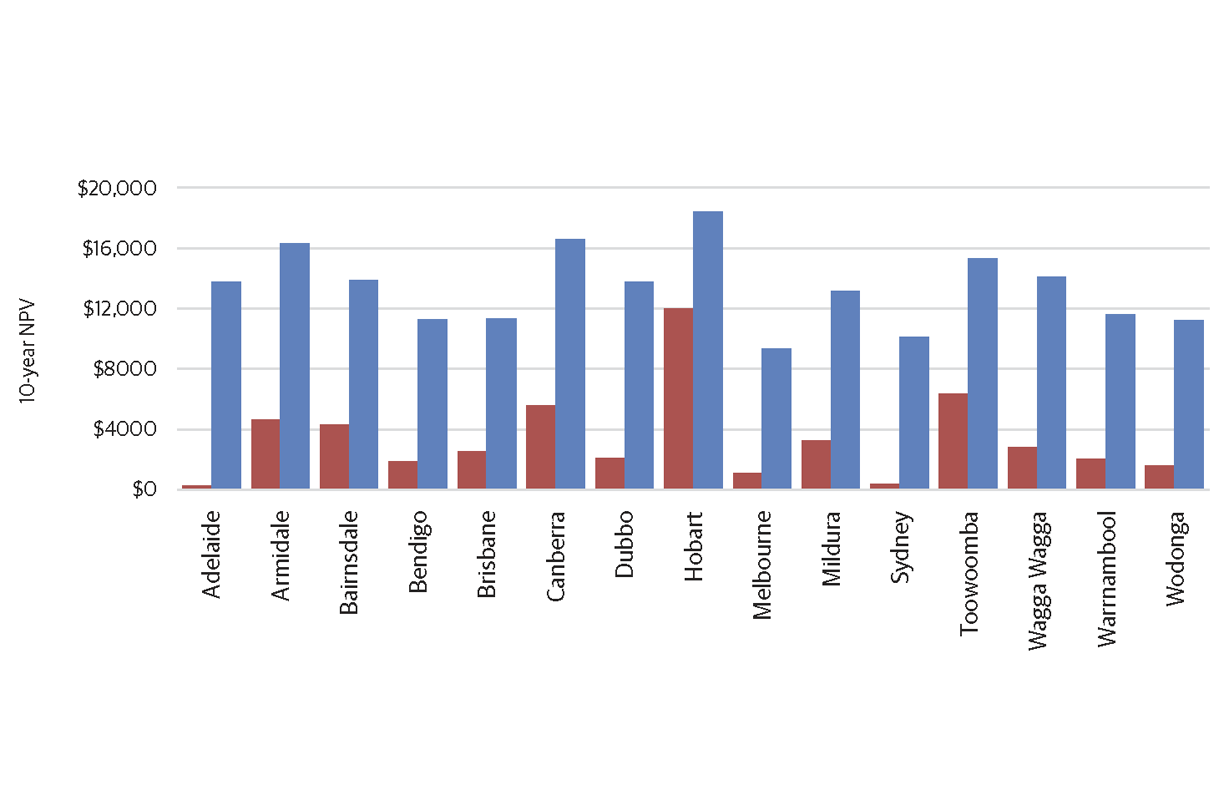
If you have only one gas appliance
We found that it is always better to replace your last gas appliance (when it is due for replacement) with an efficient electric one, in all circumstances and locations. Even in places where the running costs of gas are lower than for electric appliances, abolishing the fixed charge of the gas connection outweighs this. The smallest benefit is for a small house in Hobart, but even in this case the 10-year NPV is greater than $1000. Figure 2 illustrates this when the last gas appliance is hot water.
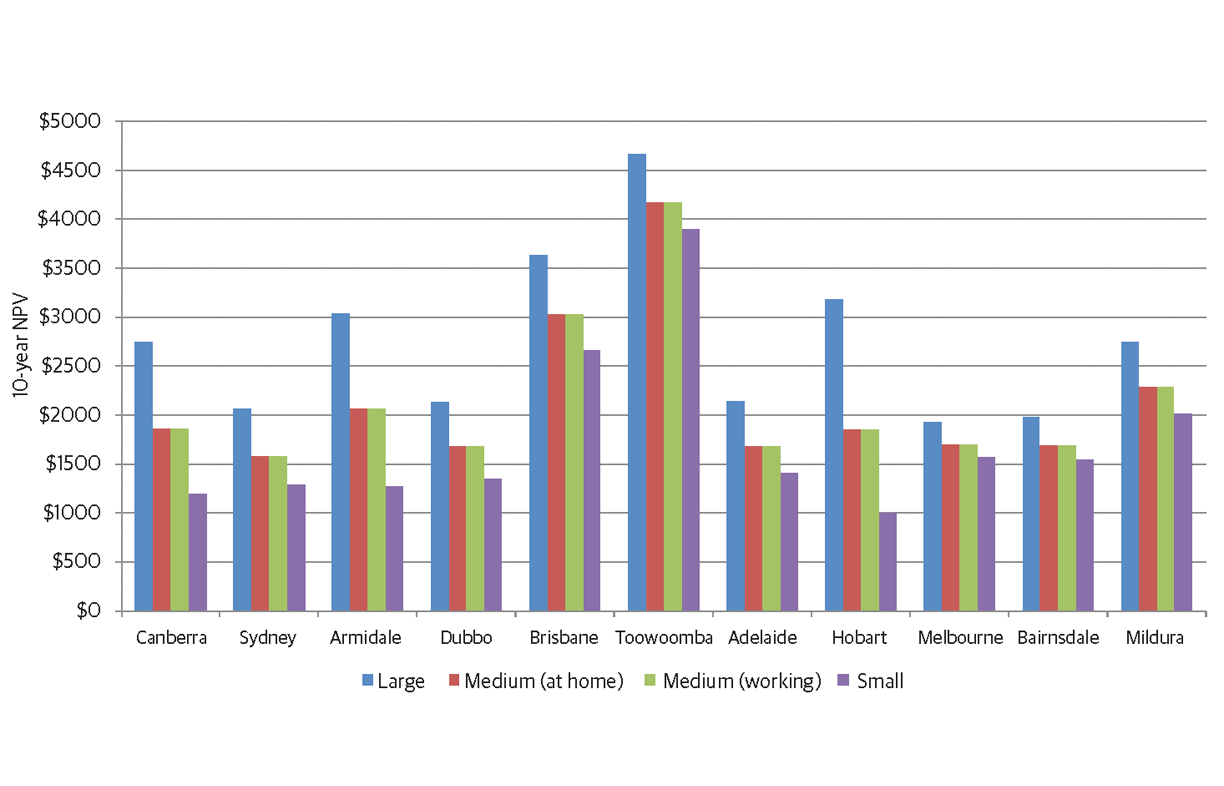
If you have more than one gas appliance
The situation is more nuanced if you have more than one gas appliance and one of them fails.
If a gas space heater fails
If a gas space heater fails, our modelling suggests it will be cheaper overall in all locations if you replace it with efficient electric reverse-cycle air conditioners. However, in Sydney the benefits are marginal, where it will cost about the same as sticking with gas.
But should you replace other gas appliances at the same time? If you also have a gas stove, switching a working stove to electric at the same time as the heater gives a financial benefit in all locations. If you have both a gas stove and gas hot water, there’s still a financial benefit in most places (and marginal benefit in a few) in switching them to electric at the same time, except in Sydney (see Figure 3).
In the heater-switching scenarios, if you already have a reasonably efficient reverse-cycle air conditioner in your living area, you can use this and thus have one less new appliance to purchase/install when switching to electric. The saving from this is enough to make a marginal benefit positive and to turn a marginal loss into a marginal benefit.
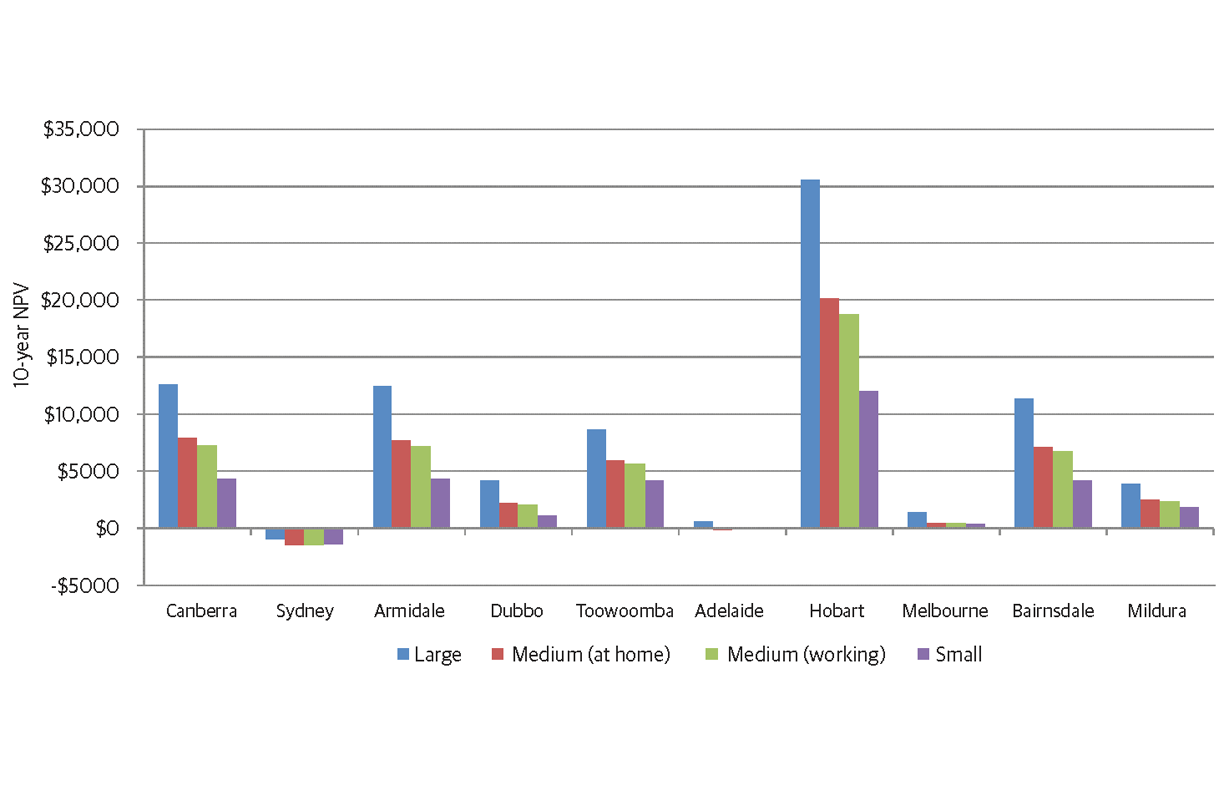
If a gas hot water system fails
If a hot water system fails and it’s not your only gas appliance, our modelling suggests you’re always better off replacing it with another gas one, unless the replacement with a heat pump is your first step towards an all-electric home. The energy usage of modern efficient gas hot water systems is too low for the greater efficiency of heat pumps to outweigh the additional capital cost; the relatively lower gas prices in many areas also favours gas hot water systems.
If a hot water system fails and you have a working gas stove, switching both to electric at the same time is a financial benefit for large households in most locations, and all households in Queensland. For small and medium households, sticking with gas is a financial benefit in some places (e.g. Melbourne, Sydney, Adelaide and Canberra) and a marginal benefit elsewhere. Having 2.5 kW solar increases the benefit of efficient electric enough for medium and large households outside of Queensland to make switching to all-electric a neutral or positive choice (see Figure 4).
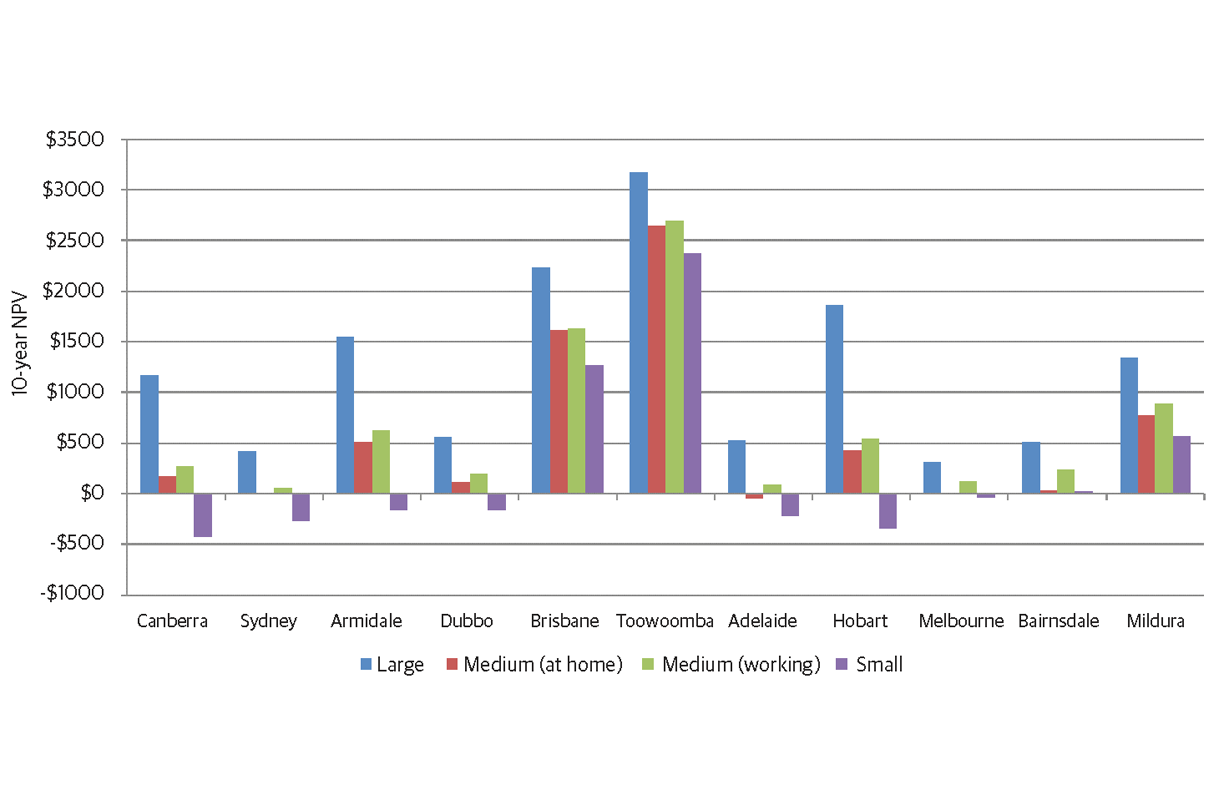
What about solar?
If you have an existing 2.5 kW solar PV system, this rarely makes an otherwise negative financial outcome into a strong positive outcome, but it does add some strength to the electric case. This is particularly the case when replacing a gas hot water system with a heat pump hot water system; for example, in places like Canberra, Armidale and Mildura, having an existing solar PV system turns a marginal benefit into a strong benefit and, in places like Adelaide, Melbourne and Bairnsdale, it turns a marginal loss into a marginal benefit (see Figure 5 for one scenario).
With the price of solar PV having fallen so much in the last 10 years, installing solar onto a roof with good solar access is almost always a good economic decision. Thus, installing new solar at the same time as replacing a failed gas appliance with a new efficient electric one tended to skew the results. Even for a household that chooses to purchase new gas appliances, solar is a good investment.

Some differences for higher users
The 2014 study showed that, in general, the higher the consumption, the better the return from going all-electric. This was because in most cases (with the main exception being cold climates with low gas prices) the running costs of efficient electric appliances were lower, while the capital costs were higher. Once the lower running cost offset the higher purchase/installation cost, the savings grew.
In the current study, while this is still mostly true, in some areas electricity prices have outpaced gas prices, diminishing the volume benefit. In a few places, gas tariffs have very steep declining blocks, which make high gas usage relatively cheaper (SA is the best example), making gas still economically preferable for high-volume users. Conversely, much higher fixed charges in many (not all) areas have amplified the benefits of cutting the gas connection, because fixed charges make up a higher proportion of the fuel bill.
What’s best for the environment?
Our previous report showed that in almost all cases, switching from gas appliances to an all-electric home would reduce greenhouse gas emissions (the only exception was in Mildura, which saw a slight increase). Since our report, the closure of coal-fired power stations like Hazelwood combined with the increased rollout of renewable energy has seen the emissions intensity of the electricity network decrease, further strengthening the environmental benefit of replacing gas appliances with efficient electric ones. We will include updated analysis on emissions in the full report.
Next up…
These results are just a high-level overview of our findings. While these key principles give good general guidance, the full summary report will break down the results across the 16 different locations, while the full report gives detailed results for every scenario and household type in all locations. See the full report on the Renew website.
Net present value (NPV)
Costs and benefits are expressed as net present value (NPV) over 10 years. This expresses the value in today’s dollars, accounting for inflation, with a higher NPV being better. For example, where a large home replaces a gas storage HWS with a heat pump HWS (which is more expensive than replacing it with a new gas storage HWS), an NPV of +$2000 means that the household has saved enough from the cheaper running costs of the heat pump to pay off the higher upfront cost, and then save an additional $2000 over the 10 years. Where the 10-year NPV is between –$1000 and +$1000, we consider it ‘marginal’ because a small variance in household behaviour or purchase or installation price could make a positive NPV negative, or vice versa. This makes it an ‘either/or’ case, where the economics mean it doesn’t make much difference which fuel you choose.

This article was first published in Issue 143 (Apr-Jun 2018) of Renew magazine. Issue 143 is our building materials special, including a window buyers guide and an article on flooring options.
 Pears Report
Pears Report
Lessons from international and local efforts on energy demand
Alan Pears gives us his round-up of the main energy issues this quarter.
Read more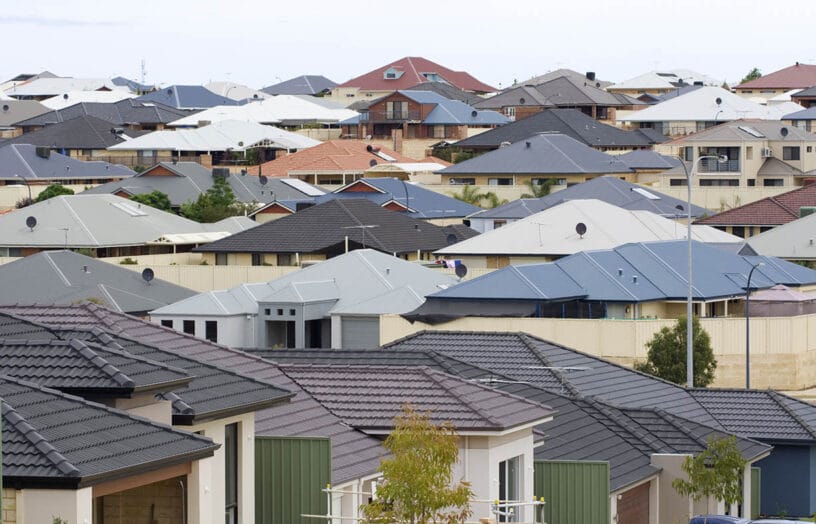 All-electric
All-electric
Mandatory disclosure of energy ratings on the horizon
Graham Hunt introduces us to a soon-to-be-implemented national framework that will be a massive win for renters and homebuyers.
Read more Pears Report
Pears Report
Energy forecasts, hydrogen hype and questions of progress
Alan Pears gives us his round-up of the main energy issues this quarter.
Read more

